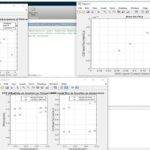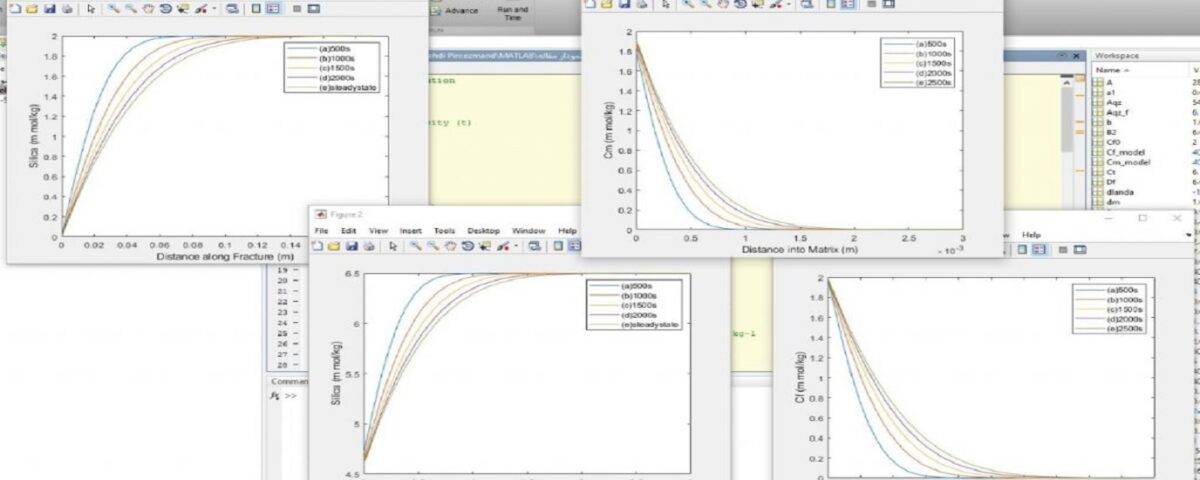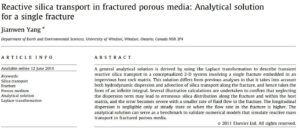Introduction
Mass transfer in porous systems, especially in materials like silica, is a crucial topic in chemical engineering, geology, and environmental sciences. These processes are of particular importance due to their wide range of applications in fields such as oil and gas reservoirs, water treatment plants, and adsorption and separation processes. One of the major challenges is understanding and modeling mass transfer mechanisms within porous pores, which are influenced by the physical and chemical properties of materials and are dependent on other factors such as temperature and pressure. Analytical solutions of the governing equations of mass transfer can provide deep insights into the behavior and characteristics of porous materials.
The aim of this research is to present an analytical model for investigating mass transfer in porous silica within a fracture and The analytical solution developed here is particularly useful in evaluating the accuracy of numerical models of reactive mass transport in fractured porous media, and also in obtaining a first-order estimate of the transport solution before numerical modeling.
The goal of studying mass transfer in porous systems is to better understand and more accurately predict how materials move within these systems.
This deeper understanding can help us in the following areas:
Improving Industrial Processes
In the oil and gas industry, it helps to extract oil and gas from underground reservoirs more efficiently.
Water Treatment
it leads to more effective removal of contaminants from water.In separation processes, it helps to better separate materials from each other. Designing new materials. By better understanding mass transfer in porous materials, we can design new materials with specific properties for various applications.
Environmental Protection
By understanding how pollutants move in soil and water, we can find better ways to prevent pollution and clean up the environment.
This modeling is based on the following article. To download the article, you can use the following link:
Click on the link below to download the original article:
Reactive silica transport in fractured porous media: Analytical solution for a single fracture
MATLAB: A Matrix Laboratory
MATLAB is a high-level language and interactive environment that was originally designed to perform matrix manipulations. The name MATLAB stands for MATrix LABoratory. It provides a convenient way to solve mathematical problems, plot data, and implement algorithms. The language is easy to learn and use, even for those who are not programming experts.
In MATLAB, everything is a matrix. A single number is a 1×1 matrix, a character string is a matrix of characters, an image is a 3D matrix of pixel values, and so on. This matrix-based approach makes MATLAB particularly well-suited for tasks involving linear algebra, numerical analysis, and data visualization.
Simulating Mass Transfer in Porous Media Using MATLAB
This project focused on simulating the movement of substances within materials containing tiny pores, such as silica. This phenomenon is crucial in various industries, including oil and gas, water treatment, and materials science. To better understand this process, MATLAB was employed to create a computational model. The simulation results closely matched the findings reported in a relevant research paper. The overall process was implemented using approximately 100 lines of MATLAB code. A schematic of the implemented model is shown in the following figure.
Conclusion
Mass transfer within porous materials, such as silica, is a fascinating and challenging subject in engineering sciences. These processes have applications in various industries, including oil and gas, water treatment, and the production of new materials. SANILCO has successfully utilized MATLAB software to develop complex mathematical models for simulating these processes. The aim of this research is to better understand the behavior of materials in porous environments, ultimately leading to improvements in industrial processes and environmental protection.




